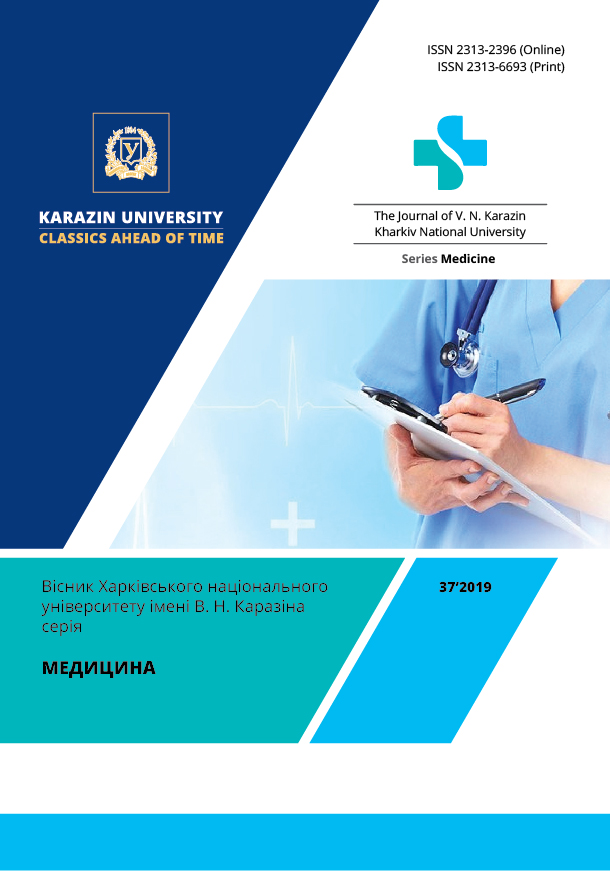Condition of the gastrointestinal tract motor function in abdominal injury
Abstract
Introduction. Injuries are a large medical and social problem. It takes many lives and is often a cause of disability. Objectives. The work is devoted to the study of the motor-evacuation function (MEF) of the gastrointestinal tract (GIT) in patients with closed abdominal injury of varying severity. Materials and methods. 125 patients with isolated or combined blunt abdominal trauma were under observation. The main criterion for the inclusion of patients in the study was the presence of injury to the abdomen and / or retroperitoneal space, confirmed while surgery or using instrumental methods of examination. The structure of injuries was dominated by a combined trauma, which was observed in 104 (83.2%) victims; in 21 (16.8%) patients abdominal injury was isolated or multiple. Evaluation of the MEF of the gastrointestinal tract was carried out using a technique developed with the participation of the author on the basis of the available indicators widely used in practice. The severity of the injury was determined on an ISS scale. Results. The results showed that the predominant part of patients with abdominal trauma (62.4%) had a violation of gastrointestinal MEF upon admission; in 21% of patients, the state of function at the border of functional compensation was noted, and only in 16% of persons, the MEF of the gastrointestinal tract was rated as moderately and completely compensated. By severity of injury, a group of patients with moderate severity (47.2%) prevailed; a mild injury was observed in 35.2% of patients, severe injury was diagnosed in 16%, and a super-severe one was in 1.6% of injured people. Conclusions. The possibility of using the MEF indicators of the gastrointestinal tract as one of diagnostic criteria for the severity of a blunt abdominal injury is assumed.
Downloads
References
Smoljar, A. N. (2016). Blunt abdominal trauma. Damage to the spleen. Part 2. Hirurgija. Zhurnal im. NI Pirogova, (2), 4–10.
Song, I. G., Lee, J. S., Jung, S. W., Park, J. M., Yoon, H. D., Rhee, J. T., & Jung, I. Y. (2016). Analysis of Abdominal Trauma Patients Using National Emergency Department Information System. Journal of Trauma and Injury, 29 (4), 116–123.
Dharmarajan, M., & Ramu, S. P. (2016). Incidence, patterns and factors predicting mortality of abdominal injuries in trauma patients. Journal of Evolution of Medical and Dental Sciences, 5 (103), 7515–7519.
Malhotra, P., Sharma, D., Gupta, S., & Minhas, S. S. (2017). Clinico epidemiological study of blunt abdominal trauma in a tertiary care hospital in north western Himalayas. International Surgery Journal, 4 (3), 874–882.
Ganzhij, V. V., & Kravec, N. S. (2014). The structure of abdominal injuries and features of therapeutic and diagnostic tactics for catatrauma.. Harkіvs'ka hіrurgіchna shkola, (5), 62–64.
Abdukhakim, M. K., & Pulat, K. S. (2015). Features of Patients Associated with Falls from Heights Admitted to Republican Research Center of Emergency Medicine. Journal of Trauma and Injury, 28 (4), 248–255.
Bojko, V. V., Bojko, V. V., Kononenko, M. G., & Kononenko, N. G. (2008). Blunt abdominal trauma.
Desjaterik, V. І., Mіhno, S. P., Bogatir'ov, M. B., Dedov, O. O., & Klіtnij, O. G. (2013). Diagnostic and medical tactics in case of combined abdominal trauma. Harkіvs'ka hіrurgіchna shkola, (2), 92–94.
Khadjibaev, A. M., & Sultanov, P. K. (2018). Algorithm of surgical treatment for combined catatrauma. Herald of Tashkent Medical Academy, 2 (30), 111–114.
Gavrilik, B. L., Kolocej, V. N., Strapko, V. P., & Hodoronok, E. I. (2015). Features of the abdominal trauma pathogenesis in patients with catatrauma: tactics, diagnosis, treatment. Zhurnal Grodnenskogo gosudarstvennogo medicinskogo universiteta, 3 (51).
Patent 19567 Ukraine, UA, IPC, A61, B 10/02. Method of estimation of motor-evacuation function of the gastrointestinal tract / O. V. Biletsky, D. V. Safronov. Kharkiv State Medical University, №20060759; application 07.07.2006; published 12/15/2006, Bul. № 12.
Lee, S. P., Sung, I. K., Kim, J. H., Lee, S. Y., Park, H. S., & Shim, C. S. (2015). The effect of emotional stress and depression on the prevalence of digestive diseases. Journal of neurogastroenterology and motility, 21 (2), 273.
Howard, K., Giblin, M., & Medina, R. (2018). The relationship between occupational stress and gastrointestinal illness: A comprehensive study of public schoolteachers. Journal of Workplace Behavioral Health, 1–16.
Czimmer, J., & Tache, Y. (2017). Peripheral corticotropin releasing factor signaling inhibits gastric emptying: mechanisms of action and role in stress-related gastric alterations of motor function. Current pharmaceutical design, 23 (27), 4042–4047.
Taché, Y., & Million, M. (2015). Role of corticotropin-releasing factor signaling in stress-related alterations of colonic motility and hyperalgesia. Journal of neurogastroenterology and motility, 21 (1), 8.
The Journal of V. N. Karazin Kharkiv National University, series Medicine has following copyright terms:
- Authors retain copyright and grant the journal right of first publication with the work simultaneously licensed under a Creative Commons Attribution License that allows others to share the work with an acknowledgement of the work’s authorship and initial publication in this journal.
- Authors are able to enter into separate, additional contractual arrangements for the non-exclusive distribution of the journal’s published version of the work, with an acknowledgement of its initial publication in this journal.
- Authors are permitted and encouraged to post their work online prior to and during the submission process, as it can lead to productive exchanges, as well as earlier and greater citation of published work.




